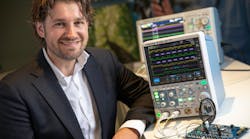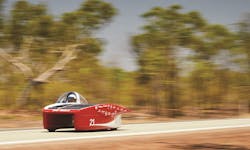Kelvin Hagebeuk of Yokogawa on Accurate Power Analysis and Solar-Powered Racing
There has always been a special place for racing in automotive systems development. Every solution developed for any application space must be tested and evaluated. From the latest smart white goods to sports/medical wearables, everything created must be confirmed as able to do the task under real-world conditions. Aspects that must be confirmed beyond the “simple” ability to serve the task include safety, reliability, and durability.
In the vehicle space there is plenty of software simulation, as well as physical testing from putting biometric dummies into crashes to dynamometer-based engine-performance testing. However, racing provides the automotive industry with the added ability to literally test to destruction advanced systems in a real-world competitive environment. The demands placed on a competitive racing vehicle create a near-perfect stress-test environment for automotive systems.
The areas of green energy and alternative-drivetrain vehicles are currently of special interest. Electric and hybrid vehicles, supported by an intelligent smart-grid-based charging network, are poised to dominate the marketplace. Solar energy is one of the areas undergoing intense development in the racing world, and one of the opportunities to compete in that space include the World Solar Challenge.
The World Solar Challenge
To win the World Solar Challenge, not only must a race car generate as much solar energy as possible, it must also manage that energy with optimum efficiency, to keep energy losses to a minimum. Add to that the need for race teams to also pay minute attention to aerodynamic design to keep wind resistance to a minimum, and you have a daunting design challenge.
Each of the electrical systems in a solar race car present their own set of needs and challenges. The array of solar panels, the battery and the power-management system, the inverter and motor drivetrain, and the motor itself, must be optimized both as individual systems and as a complete vehicle. Today’s state of the art is approaching 99% efficiency in the power-conversion circuits.
Netherlands-based Solar Team Twente is one of the many groups competing in the World Solar Challenge. In the case of RED E, the name given to Solar Team Twente’s race car, the solar array is made of GaAs solar cells, usually used in the aerospace industry. Instead of 4m2 for silicon cells, only 2.64m2 of solar array can be used of the GaAs cell type for the vehicle’s solar array.
To achieve the accuracy and precision required, the team chose the Yokogawa WT5000 for two crucial tasks. Firstly, to validate the accuracy of the ‘fuel gauge’, the on-board sensor that measures the battery’s state of charge. This required extremely accurate continuous measurement of current flows. Secondly, to measure the power output of the motor system, including the inverter and the motor itself, at a range of power input values, called for extremely accurate power analysis at a high sampling frequency.
From the press release: “We were looking for that extra 1% efficiency to give us an edge over other race cars.” according to Rob Kräwinkel, team electrical engineer, “When you are already at better than 95% efficiency, eliminating any remaining losses is really hard to do. You have to be able to look at a detailed level at tiny deviations in voltage or current. That means you need a really accurate and sensitive power measurement system.”
Presented as the most accurate precision power analyzer available, the WT5000 has a specified measurement accuracy of ±0.03%, with a measurement bandwidth of 10MHz for voltage and 5MHz for current, with maximum sampling rate of 10Msamples/s. That exceeded the data-refresh rate required to validate RED E’s fuel gauge system.
Talking About Efficiency
To get a deeper look at the issues around testing advanced vehicle power systems, we reached out to Kelvin Hagebeuk at Yokogawa about the racing team and how Yokogawa helped their efforts:
EE: Hi Kevin, glad you had the time to talk to us.
Kelvin Hagebeuk: My pleasure.
EE: Okay. So when we talk about efficiency in power systems, when we talk about competitive systems, it really takes on a different aspect, doesn't it?
Kelvin Hagebeuk: Absolutely, yes. When you consider, for instance, the race car from Solar Team, Twente, the efficiency within that system can make all the difference between winning and losing. A team is looking for every percentage of efficiency increase, because that can make a difference between winning or losing. That's as simple as that.
EE: Let’s say the design has been created, but you're trying to optimize it, you’re trying to make sure that the components can operate with each other, and the more precisely you can do that, the more effective it all is. Right?
Kelvin Hagebeuk: Yes, and that starts from the very beginning of the prototyping design phase, all the way up to the examination of the end product. You have different stages in that development cycle, and definitely precision is important there.
Let's take the racing car as an example, where you have different components working together. You have the solar panels, you have the battery, and the inverter drive. So, if you were to develop these individual parts, their efficiency is important. You need to know what performance it has. So you need to test it, you need to measure it, but then you bring all these components together and they should also cooperate and work together.
So you're interested in the dynamic between individual components, to understand how these components work together, and if the design that you created actually works. Then as you work towards the end product, you need to do an efficiency validation of the end design, where you would probably look at the evaluation of the individual components, but also at the system as a whole.
So yeah, you'll use a power analyzer to measure the efficiency of the conversion within that car, and the racing team can use that information to calculate for racing, "Okay, given the solar conditions at that day and the wind, we can calculate, how fast can we drive without the battery to run empty." Otherwise they don't meet the finish line. They use this information, the efficiency, to really plan for the race.
Especially in this case, I was really surprised by the amount of intelligence behind planning for the race, understanding the solar conditions, understanding the winds and saying, "Okay, we can drive this fast. If we drive faster, we will not make it to the finish line." But then when there's suddenly clouds that are going away, there's more solar, more sunlight. "Then okay, we can drive faster." So they are really pushing for that, every mile per hour, kilometer per hour, that makes a difference.
You can only plan for that race if you really understand what is happening in your system and the individual components. So that's why efficiency evaluation, and understanding the dynamic behavior of these different components is so important. It really makes a difference between winning and losing in the end.
EE: Exactly. One of the analogies that I once heard is, "If you're in a race, your equipment is not going to get you from not winning to winning, but it could get you from third to second, or from second to first."
Kelvin Hagebeuk: Yeah, exactly. And that's the same for these teams as well. Every year they're taking their experience, the knowledge and what they developed in the past year and said, "Okay, next year, what are the new goals, the milestones we are aiming for." And with the knowledge they have, "Okay, let's measure again." And they improved their technology.
And of course over the years, our performance, and the capabilities of our instruments become more efficient and more precise. So yeah, it's a continuous cooperation between those development teams and our instruments. That's why for us, it’s all about efficiency and accuracy
Accuracy is important because you need that accuracy in order to prove your improvements in the design. So we always have to have accurate power analyzers because our customers need that to develop the next generation of energy efficient technologies. And it's a continuous cycle of measuring, evaluation, improving that at the customer side, but also at our side as the manufacturer.
EE: Right. Well, actually another line I like using, Kelvin, is test and measurement is one of the toughest spaces in the electronics industry, because the equipment has to be better than what you're testing. The lines on your ruler, have to be closer together than the lines on theirs, or else you can't measure their accuracy.
Kelvin Hagebeuk: Yes, exactly, that's absolutely the case.That's why Yokogawa’s goal is to have the most accurate power analyzers in the world, because that makes the difference. It makes all the difference. If you go back in time, I'm not sure if you're aware but Yokogawa is quite an old company, we were founded in 1915, and at that time it was the second industrial revolution and nowadays you hear about the fourth industrial revolution.
But at that time in 1915, the world was moving away from steam in the factories, they were using steam to manufacture products, and they're moving to electricity. And that's how it started, for Yokogawa was the first company to develop a meter to measure the power consumption in those factories. Now we are working on electric vehicles 100 years later, and we are still leading in power measurement. It's been a continuous ride of improving the accuracy of our products, of our power meters and power analyzers, to meet the world's development requirements in order to develop the next generation of technology.
Zero-emission technologies are very important to us, to move away from fossil energy sources to electricity and renewable energies. That's why it's great, you can see the linkage between the power market, to the energy generating market, and to the automotive industry. If everything moves to electrification, we are there to help improve the efficiency and to reduce the emission, that's a great thing to work on.
EE: Agreed. Now tell me a little bit about the WT 5000 and put it in context of how it's being used to achieve these goals.
Kelvin Hagebeuk: Yeah. So just to go back to the solar team case. They have different components in the cost, and an array of solar panel curators, the battery and the battery management system, and then that battery output of the battery feeds the inverter, which is the heart of the motor drive, which powers the motors and the wheels.
Where the WT 5000 in this case was used, is to validate the accuracy of the fuel gauge. So there's an onboard sensor that measures the battery state of charge, and that system measures the current flow into the battery that's coming from the solar panels and flowing out of the battery to the motor.
That's the information they require to have to plan for a race, that determines how fast they can drive, and for that they need to be able to measure the current going in and out of the battery. They actually found that their current sensor had an offset. They used the precision and the accuracy of the power analyzer to determine that the sensor that is in the car to measure that flow of current was not precise enough.
Imagine if they would not have known that it wasn't precise enough, they might be misinterpreting the actual power available for them during the race, which might result in the fact that the car will stop before the finish line. So, by using the power analyzer they found out they have to compensate for that error which they found, and recalculate the actual power which is lacking in the battery. So, that's an example of how they used the precision of the power analyzer to determine that there was an offset set in their system. And without that, they wouldn't have known.
EE: Excellent. Okay then. So, now then Kelvin, looking at it from that perspective, what are some of the other aspects of the design and development process that the device can address?
Kelvin Hagebeuk: Yeah, of course. Like I said, often our power analyzers are used to do efficiency validation. So, they're really going to measure at the end, the progress in the design, they design according to design specifications, and they have a certain target for the efficiency of the product.
These engineers are very smart, so they know what they're working on and they know what efficiency they want to achieve. But then at the end you need proof that, "Okay, that's the case. This is as efficient as we thought it would be, or as we expected or designed it." But you need to prove it and validate it. And for the team it's important because they need to know if the data that they base their race standing upon, is actually factually true. So it's to take out the uncertainty.
But for a manufacturer that develops the individual components, of course, you need to prove that, "Hey, this design actually is that efficient and here's the proof because we have an accredited calibrated power analyzer, and this is the proof that the efficiency is right." And so it's almost like the quality gate at the end of the production line.
But of course, during that development process, when you're developing the individual components, a power analyzer is a great tool to see as you go, as you move through that process and development cycle to check if, "Yeah okay. Is the power that I see, is it there?" "Yes, correct." "And what is the efficiency?" I can already measure this efficiency of this individual component. So then when you put all the components together, you'll understand the total behavior of the system. So it's also used in that sense or to develop the individual components.
EE: Okay then, Kelvin. So then, to close out, do you have any last words you'd like to leave for the audience?
Kelvin Hagebeuk: Well, yes I do. Like this example of the case study with the solar team, for us it's important to enable our customers to speed up the development of the next generation of sustainable technology and innovation. And like this example, we provide trustworthy precision measurement to, with the ultimate goal, to reach net zero emissions. And that's very important to us, zero emission technology. So, this is an example where we help the customer to develop that. And yeah, that's our goal, ultimate goal, to work on that.




